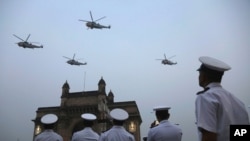In a significant move to strengthen defense cooperation between India, Japan, Australia and the United States with an eye on countering China, New Delhi is firming up plans to invite Australia to take part in naval exercises in the Indian Ocean.
India has been wary about including Australia in the annual Malabar exercises due to fears of antagonizing China, but the recent military confrontation with Beijing along their Himalayan border will prompt New Delhi to deepen strategic ties with Indo Pacific countries, according to analysts.
“India was moving in that direction, but China’s aggressive behavior has accelerated the pace of India partnering with the U.S. and other like-minded countries like Australia and Japan,” says Rajeswari Rajagopalan Pillai, distinguished fellow at the Observer Research Foundation in New Delhi.
New Delhi is expected to invite Australia later this month following clearances at the top level and consultations with the U.S. and Japan, according to Indian defense officials who cannot be quoted due to rules.
“It is almost done,” says former navy spokesman D.K. Sharma. “Countries like India and Australia see no option but to come into a construct which will aim to contain Beijing.”
Australia’s participation in the maritime exercises would see four key naval powers in the region come together at a time when broad territorial claims made by Beijing in the South China Sea have triggered growing concerns.
The Malabar naval drill, originally a bilateral exercise between India and the US, was expanded to include Japan as a permanent member in 2017. It has occasionally also included other countries like Singapore.
Australia also participated in the Malabar exercises in 2007 but following vociferous objections by Beijing, Canberra did not return to the drills. Although it has expressed its desire to take part in recent years, India, wary of Chinese sensitivities, did not give the nod.
“Australia sees value in participating in quadrilateral defense activities in order to increase interoperability and advance our collective interests in a free, open, and prosperous Indo-Pacific region,” the Australian Department of Defense spokesman said in an emailed response adding that it has yet to receive an invitation.
The widely expected inclusion of Canberra in the Malabar naval exercises will be significant for the informal grouping of US, India, Australia and Japan known as the Quadrilateral or Quad that was first formed in 2004 and revived in 2017 amid worries about China’s growing influence in the region.
“It would transform the quadrilateral into something more action-oriented and this in turn would suggest New Delhi's willingness to support a concrete move to counterbalance China, something it has long resisted doing,” according to Michael Kugelman, the deputy director of the Asia Program at the Wilson Center in Washington. “In effect, India now recognizes that being cautious with China no longer best serves its interests, rather this position is detrimental to them.”
After steadily deepening a strategic partnership with Washington and Japan, New Delhi is moving in the same direction with Australia – in June the two countries signed an agreement to allow access to each other’s military bases following a virtual summit between Indian Prime Minister Narendra Modi and Australian Prime Minister Scott Morrison. The pact clears the way for more military exchanges and exercises in the Indo-Pacific region.
In recent years, New Delhi has also been building closer ties with South East Asian countries like Vietnam and the Philippines, which are embroiled in disputes with Beijing over territorial claims in the South China Sea.
“Southeast Asian countries have long welcomed a larger role for India in the South China Sea as a way to balance China's growing influence there,” says Jeff Smith from the Asian Studies Center at the Heritage Foundation in Washington. “The more that influential partners are active there and vocal about upholding international rules and norms, the more difficult it is for China to exert hegemonic control.”
Although India’s primary concern focuses on the Indian Ocean region, where Beijing has expanded its influence by building ports in countries like Sri Lanka, it has spoken of supporting freedom of navigation in the disputed waters. The foreign ministry said this week that the South China Sea was “part of global commons and India has an abiding interest in peace and stability in the region."
The Malabar exercises could take on a more significant role in the future as the flare-up in India’s border disputes with China in the Himalayas that killed 20 Indian soldiers has led to a trust deficit that might be hard to bridge.
“For example, in the future, the four countries could come together for coordinated patrols of the Indo Pacific region,” says Rajagopalan. “India has always been apprehensive about joint patrols, but this could signal a change. I think the clash in the Himalayas has been a game-changer in India’s national security thinking. It cannot be business as usual with China.”




